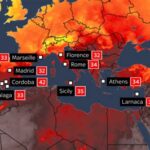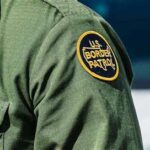
North Korea has deployed unidentified balloons near a naval warship at an undisclosed location, according to recent satellite imagery, raising concerns about potential military applications and espionage activities.
Satellite images analyzed by experts reveal the presence of several large, white balloons tethered near what appears to be a North Korean naval vessel. The purpose of these balloons remains unclear, but analysts suggest they could be used for various purposes, including surveillance, electronic warfare, or even as decoys to confuse enemy forces. “The deployment of these balloons near a warship is unusual and warrants close monitoring,” stated a security analyst familiar with the imagery. “It’s difficult to ascertain their exact purpose without further investigation, but the timing and location are certainly noteworthy.”
The appearance of these mystery balloons coincides with heightened tensions on the Korean Peninsula, marked by increased missile tests by North Korea and joint military exercises between the United States and South Korea. The incident underscores the unpredictable nature of North Korean military activities and the challenges in deciphering their intentions.
Possible Purposes and Implications
Several theories have emerged regarding the potential uses of these balloons. One possibility is that they are part of a low-tech surveillance system, providing a cost-effective way to monitor naval activity in surrounding waters. Equipped with cameras or other sensors, the balloons could transmit real-time intelligence back to North Korean command centers.
Another theory suggests that the balloons could be used for electronic warfare, potentially disrupting enemy communications or radar systems. By carrying jammers or other electronic devices, the balloons could interfere with the operation of nearby naval vessels or aircraft.
A third possibility is that the balloons are intended as decoys, designed to confuse enemy forces and complicate targeting decisions. In a conflict scenario, the balloons could present false targets, diverting attention and resources away from actual military assets.
“We cannot rule out any of these possibilities at this stage,” said a military intelligence expert. “The North Koreans have a history of employing unconventional tactics, and these balloons could be part of a broader strategy to enhance their military capabilities and deter potential adversaries.”
The deployment of these balloons also raises questions about North Korea’s compliance with international agreements and norms. While the use of balloons for civilian purposes is generally permitted, their use for military purposes could be seen as a violation of international law, depending on the specific circumstances.
Historical Context and Precedents
North Korea has a history of using balloons for various purposes, including propaganda dissemination and meteorological research. In recent years, there have been reports of North Korea sending balloons carrying trash and other debris across the border into South Korea, a move that has been widely condemned as a provocative act.
In the past, North Korea has also been accused of using balloons for espionage activities, attempting to gather intelligence on South Korean military installations and political leaders. The current deployment of balloons near a naval warship suggests a possible continuation of these activities, albeit with a potentially more sophisticated approach.
The use of balloons as a military tool dates back to the early days of aviation, with balloons being used for reconnaissance and bombing during World War I. While balloons have largely been replaced by more advanced technologies, they remain a relatively inexpensive and versatile option for certain military applications.
International Response and Monitoring Efforts
The international community is closely monitoring the situation on the Korean Peninsula, with particular attention being paid to North Korea’s military activities. The United States and its allies have repeatedly called on North Korea to cease its provocative actions and return to dialogue on denuclearization.
“We are aware of the reports regarding the deployment of balloons near a North Korean naval vessel,” said a spokesperson for the US State Department. “We are consulting with our allies and partners to assess the situation and determine an appropriate response.”
The United Nations Security Council has imposed numerous sanctions on North Korea in response to its nuclear and missile programs. These sanctions are designed to restrict North Korea’s access to funds and technology that could be used to develop its weapons programs.
However, North Korea has repeatedly defied these sanctions, continuing to pursue its military ambitions in defiance of international pressure. The deployment of these mystery balloons is just the latest example of North Korea’s willingness to challenge the international community and pursue its own agenda.
Technological Analysis of the Satellite Images
A detailed analysis of the satellite imagery reveals several key features of the balloons and their deployment. The balloons appear to be relatively large, measuring several meters in diameter. They are tethered to the ground or to the naval vessel by what appears to be strong cables.
The images also show evidence of activity around the balloons, with personnel and vehicles visible in the vicinity. This suggests that the balloons are actively being maintained and operated by North Korean forces.
The type of material used to construct the balloons is difficult to determine from the satellite imagery alone. However, based on their appearance, they are likely made of a durable and lightweight material, such as polyethylene or nylon.
The balloons are also equipped with some sort of payload, although the exact nature of this payload is unclear. It could consist of cameras, sensors, electronic equipment, or other devices, depending on the intended purpose of the balloons.
Expert Opinions and Assessments
Experts in military intelligence and security studies have offered various assessments of the significance of the balloon deployment. Some believe that it is a relatively minor incident, intended primarily to test the reactions of the international community.
Others see it as a more serious development, suggesting that North Korea is actively seeking to enhance its military capabilities and expand its surveillance network.
“The deployment of these balloons should not be dismissed as a mere prank,” said a retired intelligence officer. “It is a clear signal that North Korea is continuing to develop its military capabilities and is willing to take risks to achieve its objectives.”
The incident also highlights the challenges of monitoring North Korea’s military activities, which are often shrouded in secrecy and conducted in remote locations. Satellite imagery is a valuable tool for gathering intelligence on North Korea, but it is not always sufficient to determine the exact purpose and capabilities of its military assets.
Future Developments and Potential Scenarios
The situation on the Korean Peninsula is likely to remain volatile in the coming months, with the potential for further provocations and escalations. North Korea is expected to continue its missile tests and other military activities, despite international condemnation and sanctions.
The deployment of these mystery balloons adds another layer of uncertainty to the situation, raising concerns about potential military applications and espionage activities. The international community will need to remain vigilant and closely monitor North Korea’s actions to prevent any further escalation of tensions.
One possible scenario is that North Korea will continue to deploy these balloons near its naval vessels and other military installations, gradually expanding its surveillance network and enhancing its electronic warfare capabilities.
Another scenario is that North Korea will use the balloons as part of a larger military exercise, simulating attacks on enemy targets and testing its defenses.
A third scenario is that the balloons will be used for more aggressive purposes, such as launching attacks on South Korean or US military assets. While this is less likely, it cannot be ruled out entirely, given North Korea’s history of provocative behavior.
The Role of Propaganda and Psychological Warfare
North Korea has a long history of using propaganda and psychological warfare to influence public opinion and undermine its adversaries. The deployment of these mystery balloons could be part of a broader effort to sow confusion and uncertainty, and to project an image of strength and defiance.
By deploying these balloons near a naval warship, North Korea may be seeking to send a message to the United States and South Korea, demonstrating its ability to monitor their military activities and potentially disrupt their operations.
The incident also highlights the importance of countering North Korea’s propaganda efforts and providing accurate information to the public. This can be achieved through a variety of means, including media campaigns, public education programs, and diplomatic engagement.
Conclusion
The deployment of mystery balloons near a North Korean naval warship is a concerning development that warrants close monitoring. While the exact purpose of these balloons remains unclear, they could be used for various purposes, including surveillance, electronic warfare, or decoys.
The incident underscores the unpredictable nature of North Korean military activities and the challenges in deciphering their intentions. The international community must remain vigilant and continue to exert pressure on North Korea to cease its provocative actions and return to dialogue on denuclearization.
The situation on the Korean Peninsula is likely to remain volatile in the coming months, with the potential for further escalations. It is essential that all parties involved exercise restraint and avoid any actions that could further escalate tensions.
The deployment of these balloons serves as a reminder of the complex challenges facing the international community in dealing with North Korea. A comprehensive approach is needed, combining diplomatic engagement, economic sanctions, and military deterrence, to prevent North Korea from further developing its weapons programs and destabilizing the region.
Frequently Asked Questions (FAQ)
1. What is the purpose of the mystery balloons spotted near the North Korean warship?
The exact purpose is currently unknown, but possible uses include surveillance of naval activity, electronic warfare to disrupt communications, or acting as decoys to confuse enemy forces. Experts suggest a thorough investigation is required to determine their specific function.
2. How were these mystery balloons discovered?
These balloons were identified through the analysis of recent satellite imagery by security analysts. These images revealed large, white balloons tethered near what appears to be a North Korean naval vessel, prompting further investigation and speculation.
3. What international reactions have followed the discovery of these balloons?
The United States and its allies have expressed concern and are closely monitoring the situation. A spokesperson for the US State Department mentioned consultations with allies and partners to assess the situation and determine an appropriate response.
4. Is this the first time North Korea has used balloons for potentially military purposes?
No, North Korea has a history of using balloons for various purposes, including propaganda dissemination, meteorological research, and alleged espionage activities. Past incidents include sending balloons carrying trash across the border into South Korea.
5. What are the possible implications of this balloon deployment for the Korean Peninsula?
The deployment raises concerns about heightened tensions and potential military applications. It underscores the unpredictable nature of North Korean military activities and could lead to further provocations or escalations in the region. The incident may also impact ongoing diplomatic efforts and negotiations.









